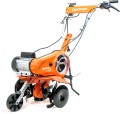Speed rotation
The speed of rotation of the cutters provided by the two-wheel tractor in normal operation. For models with several gears and, accordingly, several speed options, this paragraph usually gives the maximum speed.
The value of this parameter directly depends on the type of cutter used in the two-wheel tractor. In models with active rototillers (see below), only the intensity of cultivation and the degree of crushing of the soil depend on the rotation speed; it is believed that it should be at least 270 – 280 rpm. And in motor cultivators, where the cutter is installed on the power axis of the unit (the so-called axial structure), the overall speed of movement will also depend on its speed — and it should not be too high, otherwise the user simply will not keep up with the unit. In such models, manufacturers select the rotation speed depending on the diameter of the cutter so that the speed of the machine in the end is less than 6 – 7 km/h. Therefore, in large motor cultivators, the rotation speed usually does not exceed 130 rpm, and in compact battery models with small diameter cutters, it can reach 300 rpm and even more.
Gears
The number of gears provided in a self-propelled cultivator/motor-block, put simply, is the number of movement speeds. There are models as simple as
motor-blocks with 1 gear or
2 gears, as well as more advanced ones with
three,
four, and even
6 gears. Lower gears are not fast but allow you to handle high loads effectively and are better suited for starting from a stop; higher gears provide low traction effort but good speed. Thus, having multiple gears allows for adjusting the machine's operation mode to suit the situation's specifics.
It is worth noting that some models have the ability to move the machine in reverse—this is done by changing the direction of wheel or cutter rotation to the opposite. This function provides additional maneuverability options; it is especially useful in heavy machinery, which would be inconvenient to pull manually. The number of gears is also relevant for reverse movement, as there are
motor-blocks and cultivators with 1 gear and
more for reverse as well.

